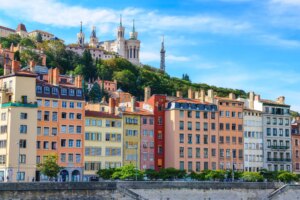Geography
Location:
Metropolitan France: Western Europe, bordering the Bay of Biscay and the English Channel, between Belgium and Spain, southeast of the UK; bordering the Mediterranean Sea, between Italy and Spain.
Since 2000, five French overseas entities, French Guiana, Guadeloupe, Martinique, Mayotte, and Reunion, have become French regions and are part of France proper:
French Guiana: Northern South America, bordering the North Atlantic Ocean, between Brazil and Suriname.
Guadeloupe: Caribbean, island between the Caribbean Sea and the North Atlantic Ocean, southeast of Puerto Rico.
Martinique: Caribbean, island between the Caribbean Sea and North Atlantic Ocean, north of Trinidad and Tobago.
Mayotte: Southern Indian Ocean, island in the Mozambique Channel, about half way between northern Madagascar and northern Mozambique.
Reunion: Southern Africa, island in the Indian Ocean, east of Madagascar.
There are also other overseas French overseas territories which are not regarded as being part of France proper. They are French Polynesia, New Caledonia, Saint Barthèlemy, Saint Martin, Saint Pierre and Miquelon and Wallis and Futuna.
Geographic coordinates:
Metropolitan France: 46 00 N, 2 00 E
French Guiana: 4 00 N, 53 00 W
Guadeloupe: 16 15 N, 61 35 W
Martinique: 14 40 N, 61 00 W
Mayotte: 12 50 S, 45 10 E
Reunion: 21 06 S, 55 36 E
Area: 643,801 sq km of which 551,500 sq km is Metropolitan France
Country comparison to the world: 43
Land: 640,427 sq km of which 549,970 sq km is Metropolitan France
Water: 3,374 sq km of which 1,530 sq km is Metropolitan France
Land boundaries:
Metropolitan France: 2,889 km
Border countries: Andorra 56.6 km, Belgium 620 km, Germany 451 km, Italy 488 km, Luxembourg 73 km, Monaco 4.4 km, Spain 623 km and Switzerland 573 km.
French Guiana: 1,183 km
Border countries: Brazil 673 km and Suriname 510 km.
Coastline: 4,853 km of which Metropolitan France has 3,427 km.
Climate:
Metropolitan France: Generally cool winters and mild summers, but mild winters and hot summers along the Mediterranean; occasional strong, cold, dry, north-to-north westerly wind known as the Mistral.
French Guiana: Tropical; hot, humid; little seasonal temperature variation.
Guadeloupe and Martinique: Sub-tropical tempered by trade winds; moderately high humidity; rainy season (June to October); vulnerable to devastating cyclones (hurricanes) every eight years on average.
Mayotte: Tropical; marine; hot, humid, rainy season during north-eastern monsoon (November to May); dry season is cooler (May to November).
Reunion: Tropical, but temperature moderates with elevation; cool and dry (May to November), hot and rainy (November to April).
Terrain:
Metropolitan France: Mostly flat plains or gently rolling hills in north and west; remainder is mountainous, especially Pyrenees in south, Alps in east.
French Guiana: Low-lying coastal plains rising to hills and small mountains.
Guadeloupe: Basse-Terre is volcanic in origin with interior mountains; Grande-Terre is low limestone formation; most of the seven other islands are volcanic in origin.
Martinique: Mountainous with indented coastline; dormant volcano.
Mayotte: Generally undulating, with deep ravines and ancient volcanic peaks.
Reunion: Mostly rugged and mountainous; fertile lowlands along coast.
Elevation extremes:
Lowest point: Rhone delta -2 m located in Metropolitan France.
Highest point: Mont Blanc 4,807 m located in Metropolitan France.
Natural resources:
Metropolitan France: Coal, iron ore, bauxite, zinc, uranium, antimony, arsenic, potash, feldspar, fluorspar, gypsum, timber and fish.
French Guiana: Gold deposits, petroleum, kaolin, niobium, tantalum and clay.
People and society
Nationality:
Noun: Frenchman(men) French woman (women)
Adjective: French
Ethnic groups:
Metropolitan France: Celtic and Latin with Teutonic, Slavic, North African, Indo-Chinese, and Basque minorities.
Overseas Departments: Black, white, mulatto, East Indian, Chinese and Amerindian.
Languages:
Metropolitan France: French (official) 100 percent, rapidly declining regional dialects and languages (Provencal, Breton, Alsatian, Corsican, Catalan, Basque, and Flemish).
Overseas Departments: French, Creole patois, Mahorian (a Swahili dialect).
Religions:
Metropolitan France: Roman Catholic 83 percent-88 percent, Protestant 2 percent, Jewish 1 percent, Muslim 5 percent-10 percent and unaffiliated 4 percent.
Overseas departments: Roman Catholic, Protestant, Hindu, Muslim, Buddhist and Pagan.
Population:
65,630,692 (July 2012 est.) of which 62,814,233 is for Metropolitan France.
Country comparison to the world: 21
Age structure:
0-14 years: 18.5 percent (male 6,180,905/female 5,886,849)
15-64 years: 64.7 percent (male 21,082,175/female 21,045,867)
65 years and over: 16.8 percent (male 4,578,089/female 6,328,834)
Median age:
Total: 39.9 years
Male: 38.4 years
Female: 41.5 years
Population growth rate: 0.497%
Country comparison to the world: 150
Birth rate: 12.72 births/1,000 population
Country comparison to the world: 155
Death rate: 8.85 deaths/1,000 population
Country comparison to the world: 72
Major cities – population: Paris (capital) 10.41 million, Marseille-Aix-en-Provence 1.457 million; Lyon 1.456 million; Lille 1.028 million, and Nice-Cannes 977,000.
Health expenditures: 3.5% of GDP
Country comparison to the world: 171
Doctors’ density: 3.497 doctors/1,000 population
Country comparison to the world: 29
Hospital bed density: 7.11 beds/1,000 population
Country comparison to the world: 13
Education expenditures: 5.6% of GDP
Country comparison to the world: 38




